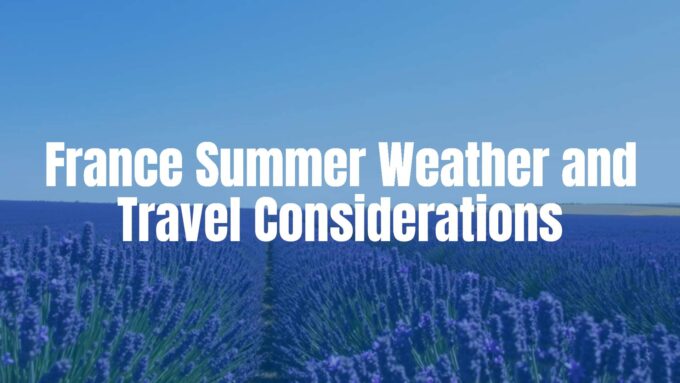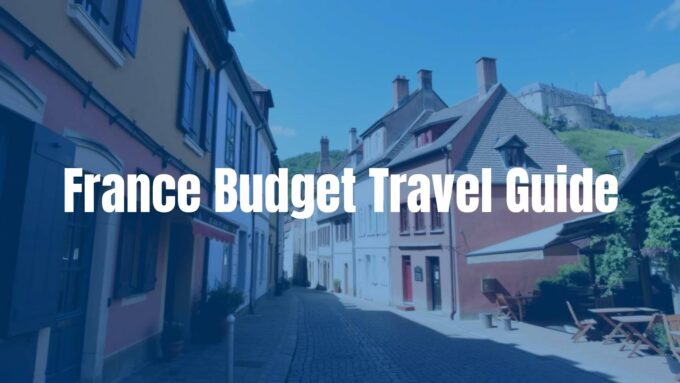French countryside itinerary ideas are more than travel tips; they open doors to the quieter side of France, away from Paris’s busy streets. These plans lead you into places where life moves slowly, traditions stay strong, and each village has a tale to tell. From warm vineyards and medieval fortresses to rugged coasts and hilltop hamlets, rural France offers many different scenes and activities. If you want to taste famous wines, visit historic sites, or simply relax among pretty views, a good countryside plan can turn your trip into something you’ll remember for a long time.
Making a French countryside plan gives you endless choices. A city break often centers on a few main sights. The countryside invites you to take your time. Taste local dishes, find small surprises, and feel the rhythm of village life. This guide shows how to plan such a trip and shares ideas to help you build your own French escape.

What Are French Countryside Itinerary Ideas?
These itinerary ideas are travel plans that focus on rural France rather than big cities. They highlight small towns, historical landmarks, regional food and wine, and scenery that ranges from gentle rivers to mountain peaks. The goal is to slow down, discover, and connect with local culture.
The main idea is to offer a structure so you can see the “true heartbeat” of France in its villages and small towns. Each place has its own style, from cobbled lanes to craft workshops. From Normandy’s cliffs to the purple fields of Provence, these plans reflect what makes each area special.
Who Should Consider a French Countryside Trip?
A countryside trip suits many kinds of travelers who want more than big-city sights. History, art, and culture fans can tour medieval castles, abbeys, and places tied to major art movements. Food and wine lovers can join vineyard tours, cooking classes, and enjoy regional dishes.
Outdoor fans will love the variety: Brittany’s coast paths, the Pyrenees’ hiking routes, and places for cycling and water sports. Families can mix learning and fun with castle visits and farm stops. Anyone who wants a slower pace and an authentic feel for France will enjoy it here.
How to Match Itinerary Ideas with Your Travel Style?
Pick a plan that fits what you like. History fans should look at Normandy or the Dordogne for WWII beaches, caves, and castles. Love food and wine? Try Burgundy, the Loire Valley, Champagne, or Alsace. Garden and art fans can visit Giverny or towns in Provence with studios and galleries.
If you want wild scenery and outdoor time, choose Brittany’s cliffs or the Pyrenees’ mountains. If you prefer markets and pretty villages, consider Provence or inland spots near the French Riviera. Think about pace: one region in depth or several areas in a shorter time. A rental car gives freedom. Trains work well between cities if you prefer to sit back and relax, then rent locally. There’s a countryside trip for every taste.
Popular Regions for Countryside Routes
France has many rural areas with different looks and traditions. In the north, Normandy draws visitors with the D-Day beaches, the Bayeux Tapestry, and Giverny, where Monet lived and worked. Next door, Brittany offers a Celtic feel, wave-battered shores, and small fishing harbors.
Head south to the Loire Valley for storybook châteaux, vineyards, and gentle river scenes. East of that, Alsace mixes French and German styles, with timbered houses and a famous wine road. Farther south, Provence brings lavender, Roman ruins, and sunny hill towns like Gordes. The Dordogne in the southwest has prehistoric caves, castles, and rich food. Burgundy is wine heaven with Romanesque art and quiet lanes. For mountains and strong local culture, the Pyrenees bring grand views and Basque traditions. Even the French Riviera has peaceful hill villages a short drive from the coast.
How to Plan a French Countryside Itinerary
Planning your route can feel like a fun puzzle. It’s about matching your interests with places that fit them. You’re not just picking dots on a map-you’re building a trip that fits you. Take a clear, step-by-step approach and keep practical details in mind to help your journey run smoothly.
Think about timing, transport, and budget. Choices can feel like a lot, so start simple and build from there. A good plan lets you relax and enjoy once you arrive.
Factors to Consider When Planning
Keep these points in mind while planning your route:
- Interests: history, art, food, wine, markets, hiking, beaches, or scenery
- Travel group: couple, family, friends, or solo
- Budget: from château stays to simple chambres d’hôtes
- Transport: car for freedom; trains for speed between hubs
- Trip length: time shapes how many regions you can see
A shorter trip fits one area well. A longer trip can link two or three regions without feeling rushed.
Best Time of Year for Each Region
France changes with the seasons. Pick based on what you want to see and do.
| Season | Months | What to expect | Good regions |
|---|---|---|---|
| Spring | Mar-May | Mild weather, flowers, fewer crowds | Normandy, Brittany, Loire |
| Summer | Jun-Aug | Warm days, long evenings, busy hotspots | Provence (lavender late Jun-mid Jul), Riviera |
| Autumn | Sep-Nov | Harvest time, pleasant temps, fall colors | Burgundy, Alsace, Loire |
| Winter | Dec-Feb | Christmas markets, skiing, quieter towns | Alsace, Alps, Dordogne (calm) |
How Many Days Do You Need?
France is large and varied. A quick taste is possible in a few days, but one region usually needs 5-7 days. That gives you time for main sights, meals, and a slower day for rest or a surprise stop.
To link two or three regions, plan 10-14 days. For a longer route with many famous areas, three weeks or more works well. It’s better to enjoy a smaller area than rush through many stops.
Recommended Ways to Travel: Car, Train, or Guided Tour
Your transport choice shapes the trip. Pick what suits your style:
- Car: freedom to stop in small villages, explore side roads, and set your own schedule; choose a compact car for narrow lanes
- Train: fast links between major cities and some regional hubs; add local buses, taxis, or short tours at your base
- Guided tour: fixed schedule, logistics handled, and expert commentary; good for a first visit
A common plan is to take a high-speed train to a regional city, then rent a car to explore nearby towns and countryside.
Highlights of France’s Iconic Countryside Regions
France’s rural areas each have their own flavor, history, and look. From Normandy’s shores to Provence’s sunlit hills, every place brings different sights and tastes. Getting to know the highlights helps you shape a route that fits you.
These places are more than stops. They are scenes you can step into, with traditions you can taste and stories you can feel. Let’s take a closer look at some favorites.
Normandy: Coastal Villages and Historic Sites
Normandy offers green fields, cliffs, and strong ties to World War II. Visit the D-Day beaches, Omaha Beach, and Pointe du Hoc. The American Cemetery at Colleville-sur-Mer is moving and thoughtful.
Mont-Saint-Michel rises from the sea with a medieval abbey at its peak. In Bayeux, the famous tapestry shows the story of the Norman Conquest. Giverny, Monet’s home and gardens, is at its best from May to October. Seaside towns like Honfleur and half-timbered Beuvron-en-Auge invite slow walks and tastes of Camembert and cider.
Brittany: Rugged Cliffs and Picturesque Towns
Brittany has a strong Celtic spirit and a wild, rocky coast. The Pink Granite Coast near Ploumanac’h is known for large, rose-colored stones shaped by wind and waves. The lighthouse and harbor views are lovely.
Inland, Locronan has Renaissance homes and a granite church. Rochefort-en-Terre charms with a small château, cobbled lanes, and flower-filled windows. Try fresh oysters and Breton crêpes. Hike along the coast, see ancient standing stones, and walk the ramparts of Saint-Malo.
Loire Valley: Châteaux and Vineyards
The Loire Valley, the “Garden of France,” is full of grand châteaux, rivers, and vineyards. Château de Chambord showcases French Renaissance style with its famous double-helix staircase.
Château de Chenonceau stretches across the River Cher with graceful arches. At Amboise, Clos Lucé was Leonardo da Vinci’s last home. The riverside village of Montrésor has a small castle and pretty lanes. Visit wineries for crisp whites, and stop by Chedigny, the “village of roses,” in spring.

Alsace: Storybook Villages and Wine Routes
Alsace blends French and German heritage. Expect timbered houses, bright colors, and flowers. Colmar, sometimes called “Little Venice,” is full of canals and photogenic corners. Eguisheim’s ring-shaped streets feel like a fairy tale.
Follow the Wine Route for Riesling and other fine wines. Riquewihr, with vineyards at its walls and the 13th-century Dolder Tower, is a classic stop. Winter brings lovely Christmas markets. Local food is hearty and pairs well with the region’s wines.
Provence: Lavender Fields and Hilltop Towns
Provence means lavender, olive trees, and golden light. The fields around Valensole and Sénanque Abbey burst with color from late June to mid-July.
Gordes sits high over the Luberon, with stone houses and wide views. Nearby, the Village des Bories shows old dry-stone huts. Roussillon glows with red and orange cliffs. See Roman sites like the Pont du Gard and the ruins in Arles. Taste olive oil, herbs, cheeses, and wines, including those from Châteauneuf-du-Pape.

Dordogne: Medieval Castles and Prehistoric Caves
The Dordogne mixes rivers, cliffs, castles, caves, and rich food. Beynac Castle looks over the river and offers wide views. The village has golden-stone houses and steep lanes.
Lascaux IV recreates the famous cave art with great detail. You can also visit smaller caves with original paintings. Paddle a canoe along the river for views of cliff villages and fortresses. Savor duck confit, truffles, and walnut treats.
Burgundy: Wine Country and Romanesque Heritage
Burgundy produces legendary Pinot Noir and Chardonnay. Vineyards cover the hills in neat rows. Beaune, the wine capital, has the 15th-century Hospices de Beaune with its colorful roof tiles.
The region also has important Romanesque sites. Vezelay’s hilltop basilica is a UNESCO site linked to ancient pilgrim routes. In Flavigny, enjoy aniseed candies and quiet village life. Pair local dishes with the area’s famous wines.
Pyrenees: Mountain Escapes and Basque Culture
The Pyrenees form a dramatic border with Spain. Summer brings hiking and cycling; winter brings snow sports. Villages keep strong local identity and language.
Saint-Jean-Pied-de-Port is a key stop for pilgrims heading to Santiago. Walk Rue de la Citadelle and see the 17th-century Citadel. Nearby Ainhoa shows classic Basque homes with white walls and colored beams. Taste Basque cake and pintxos. Nature, history, and culture come together here.
French Riviera Hinterland: Scenic Villages Beyond the Coast
The Riviera’s inland hills hold quiet villages and lovely viewpoints, a short drive from the busy beaches. These spots offer calm streets, gardens, and long views toward the sea.
Gourdon sits high above the Gorge du Loup, with perfume shops, small boutiques, and flowered terraces. The road up is full of photo stops. Èze clings to a cliff with exotic gardens and stone lanes. Villefranche-sur-Mer keeps a village feel by the water, with a pretty port and good restaurants for sunset meals.
Must-See Villages and Towns for a Countryside Experience
France’s small towns define its rural charm. Each has its style, food, and story. To feel the country’s true character, visit these places and take your time.
If you like architecture, markets, or farm-to-table meals, you will find plenty to enjoy. Here are some favorites to add to your map.
Most Beautiful Villages of France to Add to Your Route
“Les Plus Beaux Villages de France” is a label for outstanding villages worth protecting. Add a few for classic scenes and rich heritage. In Brittany, Locronan has granite homes and a medieval church. Rochefort-en-Terre blooms with flowers around its small château.
In the Loire, Montsoreau sits where the Loire and Vienne meet, with a white-stone castle and a lively antique market. Provence offers Gordes and Roussillon, famous for ochre cliffs. Alsace brings Riquewihr and Eguisheim, with vines around the walls. Conques in Aveyron is a key stop for pilgrims with a grand abbey. Beuvron-en-Auge in Normandy has half-timbered houses and cider stops. Each village gives you a real taste of rural France.
Historic Market Towns Worth a Stop
Market towns show daily life through food, crafts, and friendly gatherings. Sarlat-la-Canéda in the Dordogne has fine medieval streets and a famous market filled with truffles, foie gras, and walnuts.
In Provence, Saint-Rémy-de-Provence hosts big markets on Wednesdays and Saturdays. L’Isle-sur-la-Sorgue is known for its Sunday antiques plus a farmer’s market. Beaune in Burgundy pairs wine culture with a lively Saturday market. Markets are great for chatting with locals, trying new foods, and soaking up the scene.

Best Spots for Local Cuisine and Farm Visits
Rural France shines in its kitchens and fields. Try these food-focused stops:
- Dordogne: Beynac-et-Cazenac for duck confit and walnut wine; Sarlat’s markets for direct-from-farm produce
- Provence: Saint-Rémy and L’Isle-sur-la-Sorgue markets for herbs, olives, cheeses; wineries in Châteauneuf-du-Pape
- Burgundy: Beaune for food-and-wine pairings and classic dishes
- Pyrenees/Basque Country: Ainhoa for Basque cake and pintxos
- Flavigny (Burgundy): taste traditional aniseed candy
These places let you taste and learn about local traditions at the same time.
Sample French Countryside Itinerary Ideas by Duration
Your time frame often sets the shape of your route. Whether you have a week or more, France offers many options. The sample plans below balance travel time and rich experiences.
Use these as starting points. Mix and match based on what you like most.
7-Day Route: From Paris to the Loire Valley and Dordogne
One week can offer a strong mix of art, history, and scenery. Fly into Paris, pick up your rental car, and drive to Giverny to see Monet’s gardens. Continue to Honfleur for the first night.
Days 2-3: Base in Bayeux to see the D-Day beaches, the American Cemetery, and the Bayeux Tapestry. Day 4: Drive to the Loire Valley and stay in Amboise or nearby. Day 5: Visit châteaux like Chenonceau and Chambord and enjoy a wine tasting. Days 6-7: Head to the Dordogne. Base in Sarlat-la-Canéda or Beynac-et-Cazenac. See castles, paddle the river, and tour a cave. Finish near a main airport or continue your travels.
10-Day Route: Normandy, Brittany, and the Loire Valley
With 10 days, you can see rugged coasts, deep history, and grand estates. Start in Paris, then move out to the countryside. Days 1-3: Focus on Normandy-Bayeux, D-Day sites (Pointe du Hoc, American Cemetery), Mont-Saint-Michel, and maybe Giverny or Honfleur.
Days 4-6: Drive west into Brittany. Walk the Pink Granite Coast near Ploumanac’h, visit Locronan or Rochefort-en-Terre, and see Saint-Malo. Days 7-10: Go to the Loire. Base in Amboise, tour Chenonceau, Chambord, and Clos Lucé, and add tastings and riverside towns. This route covers three very different areas with a steady pace.
2-Week Scenic Loop: Provence, French Riviera, and Beyond
Two weeks in the south mix beaches, villages, and ancient sites. Fly into Nice (NCE). Days 1-4: Explore Nice’s Old Town, visit Èze, swim at Paloma Beach, and see Villefranche-sur-Mer or Menton.
Days 5-9: Drive west into Provence. Stay in Gordes or Saint-Rémy. Shop markets, wander lavender fields (in season), see Roman Arles, and taste wines in Châteauneuf-du-Pape. Don’t miss Sénanque Abbey.
Days 10-14: Extend the loop. Options: the Dordogne for castles and caves, the French Alps for lakes and peaks (Annecy), or Languedoc for Carcassonne and the Canal du Midi. Fly out of Marseille or take a fast train to Paris for your flight.
Flexible Short Trips: Weekend Village and Vineyard Getaways
If you have a couple of days, pick a tight area and dig in. From Paris, Provins (about 60 miles southeast) is a UNESCO site with towers, walls, tunnels, and a June medieval festival.
Wine weekends work well too: Ville-Dommange in Champagne for small producers like Florent Bergeronneau-Marion; Vezelay in Burgundy for its basilica and nearby vines; or the Alsace Wine Route for Riquewihr and Eguisheim. A rental car helps you move at your own pace.
Recommended Thematic Itinerary Ideas
You can also plan by theme. If you love wine, castles, nature, or art and gardens, build a route around that focus. Each stop then fits your main interest, making your time feel well spent.
Here are a few themes to start with.
Wine and Gastronomy Journeys
For fine wine and good food, plan stops like:
- Burgundy: Pinot Noir and Chardonnay; base in Beaune for vineyards, cellars, and meals
- Loire Valley: crisp whites and crémants plus châteaux nearby
- Alsace: Riesling and Gewürztraminer with hearty local dishes in colorful villages
- Provence: rosé, olive oil, markets, and cooking classes in towns like Saint-Rémy
- Champagne: taste in Épernay or Reims, and visit small houses in villages like Ville-Dommange
Along the way, you learn how local land, weather, and tradition shape each bottle and dish.
Castles and Heritage Trails
Follow the past through fortresses and noble homes:
- Loire Valley: Chenonceau, Chambord, and Villandry’s gardens; add Montrésor
- Dordogne: cliff-top castles like Beynac and cave art at Lascaux IV
- Normandy: Mont-Saint-Michel’s abbey and the historic town of Provins near Paris
These routes show how people defended land, built power, and lived in different eras.
Nature and Outdoor Activities
For fresh air and active days:
- Brittany: coastal hikes along the Pink Granite Coast and hidden coves
- Pyrenees: summer hikes and rides; winter skiing; pilgrim paths from Saint-Jean-Pied-de-Port
- Provence: canyoning in the Gorge du Loup near Gourdon; lavender walks
- Alps: hikes around Chamonix; cycle the lake loop in Annecy
- Dordogne: canoe the river past villages and castles
Art, Literature, and Gardens Circuits
Follow artists and writers through inspiring places:
- Giverny (Normandy): Monet’s home, water lily pond, and Japanese bridge (best May-Oct)
- Loire Valley: Clos Lucé in Amboise for Leonardo da Vinci; formal gardens at Villandry
- Provence: Sénanque Abbey surrounded by lavender; scenes that inspired many creators
- Montrésor (Loire): small exhibitions and peaceful river views
Tips for a Memorable French Countryside Journey
A few smart choices can make your trip smoother and more fun. From where you sleep to how you drive and how you greet people, small steps can improve each day.
Use these tips to help you settle into rural life and enjoy the local pace.
Where to Stay: Hotels, Chambres d’Hôtes, and Gîtes
Pick lodging that fits your style:
- Chambre d’hôtes: family-run B&Bs in historic houses or farms; friendly hosts and homemade breakfast
- Gîtes: self-catering cottages or houses; good for families or longer stays
- Hotels: from boutique spots in old towns to château stays with classic charm

Book ahead in busy seasons to get the place and location you want.
Advice for Driving in Rural France
Driving is a great way to see small towns and scenic roads. Keep these points in mind:
- Autoroutes (toll roads) are fast but add cost; smaller roads are cheaper and more scenic
- Village streets can be narrow; a compact car helps
- Look for marked parking areas or lodging with parking
- Carry required items: registration, insurance, warning triangle, reflective vest, spare bulbs
- Drive on the right and watch speed limits; enforcement is strict
- Avoid big-city driving if you can; pick up your car outside Paris or after a train ride
Cultural Etiquette and Useful French Phrases
Simple politeness goes a long way. Always greet first, then ask your question. Some handy phrases:
- Bonjour = Hello
- S’il vous plaît = Please
- Merci = Thank you
- Parlez-vous anglais ? = Do you speak English?
- Où est… ? = Where is…?
- L’addition, s’il vous plaît = The bill, please
Arrive on time for bookings. Wait to be seated at restaurants. Meals may be unhurried. Tipping is modest; round up or leave a small amount for good service.
Packing Essentials for a Countryside Adventure
- Comfortable walking shoes for cobbles, trails, and castle steps
- Layers for changing weather; a light jacket even in summer evenings
- Light clothes and swimwear for warm months
- Camera or phone with good camera
- Plug adapters, power bank, and a daypack
- GPS or offline maps (many rentals include navigation)
- Hat, sunglasses, sunscreen year-round in sunny areas
- Reusable water bottle
Frequently Asked Questions about Traveling the French Countryside
Here are answers to common questions about timing, lodging, and getting around. These tips can help you plan with confidence and enjoy the road.
Use them to shape your schedule and pick the best options for your trip.
What Are the Best Months to Experience French Villages?
Late spring (May-early June) and early autumn (September-early October) often bring mild weather and fewer crowds. These months are great for market strolls and outdoor meals.
In May and June, flowers bloom across villages and lavender starts to color in Provence. In September and early October, wine regions like Burgundy and Alsace celebrate harvest with beautiful fall colors. July and August bring warmth and festivals, but also higher prices and crowded spots. Winter is quiet and cozy, with lovely Christmas markets in Alsace, though some small sights may have limited hours.
Should You Pre-book Accommodation?
In busy months or popular regions like Provence, the Loire, and Normandy, book ahead. Small B&Bs and unique hotels often have only a few rooms and fill up early, especially during festivals and school holidays.
Pre-booking secures the style of stay you want-B&B, gîte, or château-and helps lock in your daily route. Showing up late in a small town without a room can be stressful and limit your choices. A bit of planning brings peace of mind.
How Easy Is It to Use Public Transport Outside Major Cities?
High-speed trains connect big cities quickly. Outside those hubs, buses and regional trains run less often and may not reach small villages. Weekend and holiday schedules can be thin.
For places like hill towns in Provence, castles in the Dordogne, or wine lanes in Burgundy, a rental car is often the easiest way to move around. One smart plan is to take a train for long distances, then rent a car for a few days in each region. Some areas offer minivan tours or taxis from train stations, though they may cost more and give less freedom than driving yourself.
Final Thoughts on Creating Your Ideal French Countryside Itinerary
The French countryside gives you many paths to a great trip. What matters most is picking places and moments that fit you-tastes, pace, and interests.
You don’t need to see everything. Focus on what you enjoy: a lively market, a glass of wine at sunset, a quiet walk through a small town. Let France surprise you, one simple pleasure at a time. Bon voyage!













Leave a comment